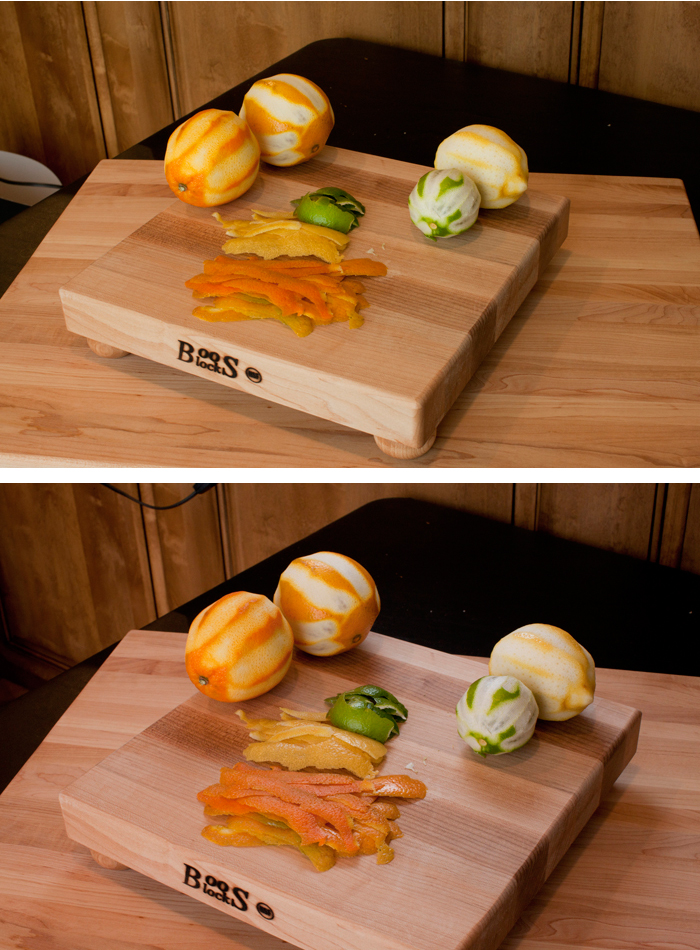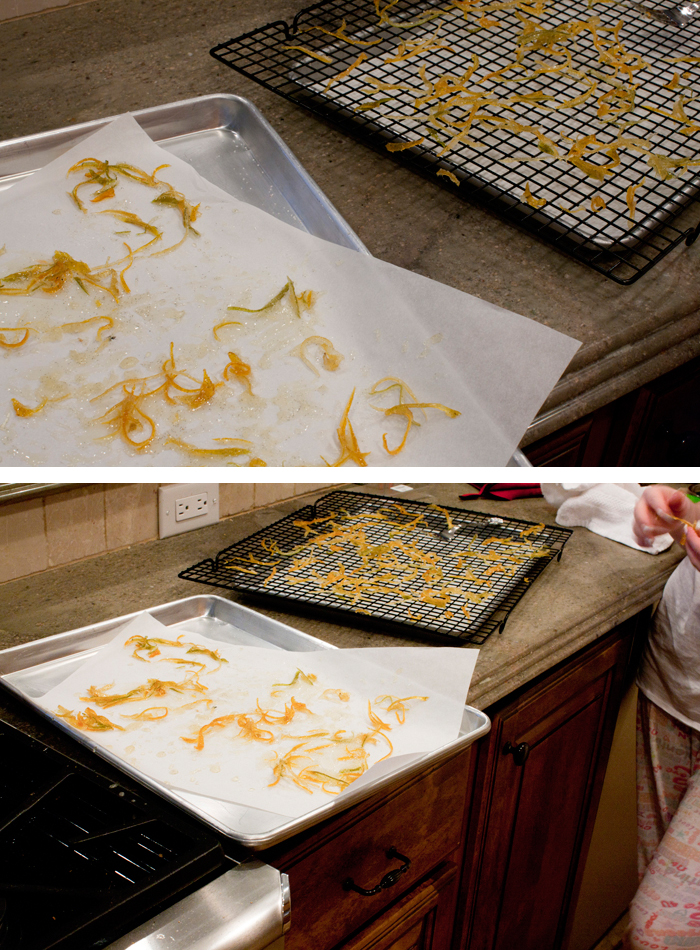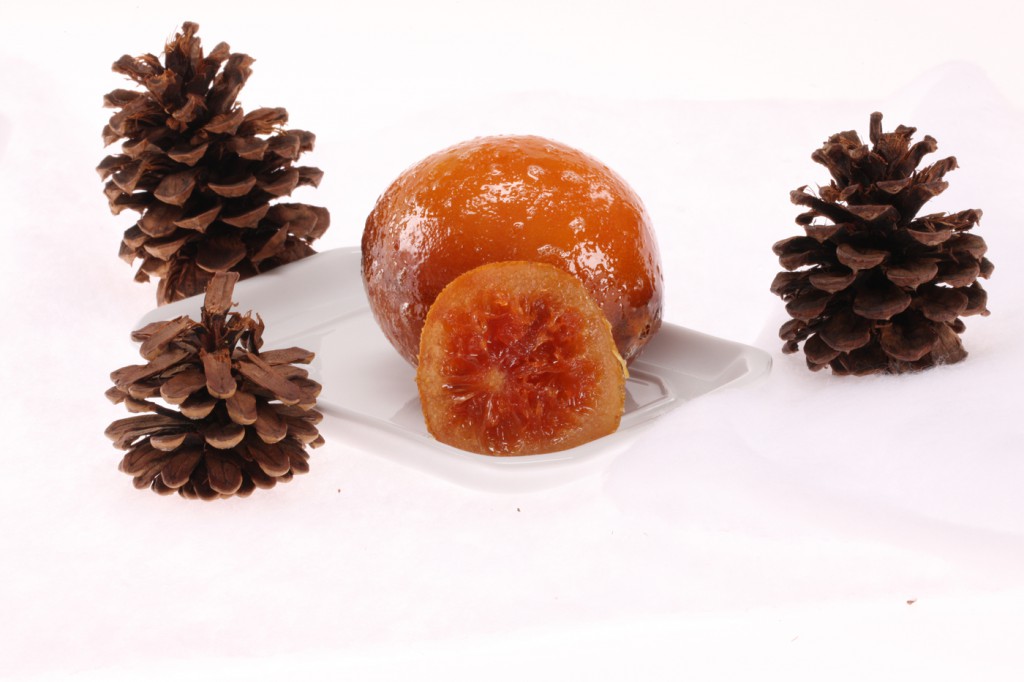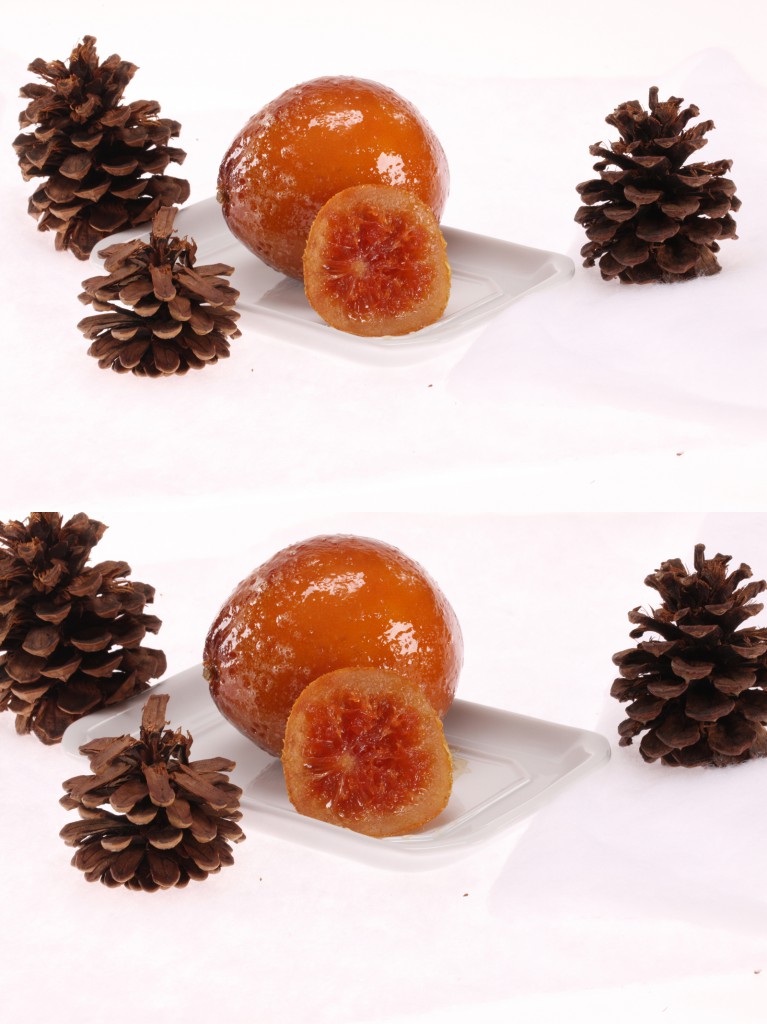It is my favorite time of the year, which I am sure has been said and sung about a zillion times in the past, however it really is my favorite time of the year. Generally the air has gone from crisp to chilly, the “Uggs” are awaken for a long awaited appearance, the smell of cinnamon, nutmeg, cloves, and citrus is in the air. That is how the idea of candying a whole citrus fruits began, I yearly create candy zest from citrus fruit for recipes and gifts. This year I wanted to try an entire citrus fruit, sounds easy right? Actually NO.. there is very little information on the method for whole candied citrus fruits or any whole large fruit. Unless you want to purchase the fruit already candied, which I did not, I wanted to candy the fruit myself!
After looking for hours on the subject, talking to tons of bakeries and Chocolate tiers we know, finding very little information on the matter. We finally, in a history book written in the year 1555, found some information. The book was by Nostradamus, he wrote one of the most remarkable French works on candy-making: “Treatise on Beauty Secrets and Preserves”. Sadly I do not own the book, but was able to find about minute worth of information.” The secret of the candying process is simple, but delicate : it consists of slowly penetrating the fruit with sugar, in several consecutive baths, so that the fruit is preserved without loosing its form, its colour, or its savour. This tradition has come down through the centuries, from the Renaissance to the present.” Besides that small quote I was unable, without owning the book, to inquire more knowledge.
We did find a 2 minute video, in french, quickly showing a confit factory candying every fruit imaginable, but alas they were using machines and vats of product. Believe or not Sydney and I began a journey of trial and error, multitudes of error, of candying whole citrus or confit. Fruit confit consists of a processes of removing all the water in the fruit and replacing it with sugar. In the middle ages when fruit was sparse confit was a miracle for the people; they could preserve their very precious fruit up to 3 to 4 months. Today we consider a whole candied fruit to be a delicacy and a wonderful gift for the holidays. However large candied fruit can be considerably expensive, with an abundance of patience it is possible to implement this method in your own kitchen. I will admit there were many batches that did not make the cut, I will try and share the mistakes along with the one success we had. Even the batches that did not make the grade were eaten or used in other recipes, the mistakes were delicious.
 Since we had planned on preparing candied citrus zest, our first thought was to use the method of candying the whole fruit with same steps as one would use for candying fruit slices minus the rind. In our favor we had yet dove into any long extensive research, just our wacky common sense.
Since we had planned on preparing candied citrus zest, our first thought was to use the method of candying the whole fruit with same steps as one would use for candying fruit slices minus the rind. In our favor we had yet dove into any long extensive research, just our wacky common sense.
Sydney and I peeled with great caution, as not to have any pith on the strips, and then cut the peel into thin strips. The strips were blanched for 1 to 2 minutes, enough time to remove the bitterness without loosing the vibrant beautiful color. The water must start cool and boil with the strips of zest in the pot. The same procedure was used with the naked citrus also, after removing the white pith from the flesh with a VERY sharp pairing knife.
With a slotted spoon the strips and naked fruit were removed from their pots of boiling water and plunged into two separate ice baths, to stop the cooking processes and keep the color. Again using a slotted spoon careful lay the zest and fruit onto a clean towel and let cool down. Sugar, corn syrup, and water were brought to a boil (in two separate pots), at this point we added the zest to one pot and the “naked” fruit to the other. The heat is reduced to low, the syrup should remain at “a kiss of a simmer” and allow the citrus to cook for about 15 minutes or until most of the syrup has evaporated and the zest appears transparent. The syrup should remain clear through out the entire simmering process, do not let it brown or caramelize. When the zest has finished it's spa bath it is ready to be transfer to a sheet of parchment paper, and while still quite warm separate the candied strips of zest, transfer to a cooling rack for about 1 hour, and roll in sanding sugar. The syrup can be saved for using as perfumed simple syrup!
The candied zest worked out perfectly, most likely because I make it yearly and I know what I am doing (I admit that does help some), the candied naked fruit tasted delicious, however was not the most attractive looking fruit. So being the stubborn perfectionist that I am, I looked at Sydney as she proclaimed “we are doing the whole citrus again” (she knows me so well).
Before I continue with the method we finally settled on, after trying more times than I care to tell, I will give you our recipe for candied citrus zest
Candied Citrus Peel
Implements needed
Citrus of choice, at least 3, our choice was 2 oranges (cara cara & navel), lemon and lime
296 grams/ 1 ¼ cup water
300 grams/ 1 ½ cup sugar
½ vanilla bean, optional
100 grams/ 1/2-cup sanding sugar
1 cutting board
1 knife
1 peeler
1 saucepan
1 sieve
1 slotted spoon
candy thermometer
1 jelly roll pan or cookie sheet
1 cooling rack
parchment paper
Use a peeler to remove the zest from the citrus. Try to remove as little of the fleshy white pith as possible. Slice the citrus peel.
Carefully cut the citrus peel into long, thin slivers. You can cut into larger strips, but it will take longer to cook.
Put the cut strips into a saucepan of cold water and bring it to the boil. Cook for 1-2 minutes to remove some of the peel's bitterness then strain with a sieve. Repeat one or two more times, without loosing the color of the zest. The last blanching gently dry the zest on a paper towel before proceeding to the next step.
Slice along the length of the vanilla bean without cutting all the way through (optional). Then carefully open it up and scrape out the pulp with the blade of the knife. Place both the bean and the pulp into a saucepan of syrup.
Add 297 grams of water and 300 grams sugar (1 1/4 cups of water and 1 1/2 cups sugar in a medium pot).
Place water, sugar, vanilla pulp, vanilla skin in the saucepan on a high heat and swirl to dissolve the sugar. Bring to the boil and add in the citrus peels. Swirl and turn down the heat. The heat should register on candy thermometer at 118º C/235ºF, the thread stage.
Simmer in the syrup for approximately 15 minutes, until soft and translucent. There should be very little syrup left in the pan. Pour the candied peels onto a jellyroll pan lined with parchment paper, while still warm transfer the peels to wire rack, separating the pieces as needed.
Let peels dry 1 hour. Toss with 100 grams/½-cup of sanding sugar to coat, you can use granulated sugar, I just love how the sanding sugar sparkles.
It is now ready to serve.
Use it to decorate cakes or any desserts, dip in chocolate , or eat as is. Stored in a sealed container, it will keep in the fridge for up to 6 months.
 This scattering of alluring color will dry and be sugared YUM!
This scattering of alluring color will dry and be sugared YUM!
The method and recipe for candied whole citrus fruit or fruit I am going give, for the record it is loosely a recipe, because the recipe can change with your needs and amount of fruit. I am going to do my best to explain what we learned through trial and error, plus reading a few of sydney's college chemistry books, on preparing candied whole fruit. Any fruit can be candied, from watermelon, pineapple, to cherries, citrus and plums. The chemistry behind persevering the fruit as I stated in the beginning of the blog is confit, depending on the size of fruit will determine how long the entire process will be. The orange we candied took a little more than 24 hours, but should have cooked longer by about 4 hours.
On Monday morning early we began to experiment again (I believe this was our 5th attempt of a whole citrus candy fruit). It started with submerging the citrus in scolding hot water for 2 minutes 45 seconds, just to blanch them, quickly, but carefully remove each citrus with a slotted spoon and immerse in an ice bath for 1 minute. repeat this processes about four time. (Each time you blanch and cool the water must be new and clean). Now it is time to start the sugar water, this is a long, delicate, but easy procedure of concentrating the syrup with more sugar each time. While the first pot of sugar and water are dissolving and coming to a thread stage, grab metal skewers (wooden ones are not up for the task at hand) begin to poke wholes all around the fruit.
Once the syrups temperature is at a registered 118º C/235º F on a candy thermometer carefully with your slotted spoon place the citrus in the syrup. Keeping the syrup at the thread stage and not letting the syrup change in color cook for about 1.5 hours, turn off the heat and allow the syrup to cool down with fruit resting inside the pan of syrup. This process continues though out the day creating thicker syrup with more sugar and less water, and adding 80 grams/1/4-cup corn syrup. As I promised I am sharing our recipe, but I did not take my orange as far as I should have to achieve transparency. The proper look for the fruits outside is to be transparent. I am in the process of making more and will post the rest of the pictures soon. I will tell say the orange was mighty tasty as is, but I am a perfectionist and i need to achieve full transparency. In fact it is excruciating for me to post this blog and have the fruit look good, but not perfect, however due to the long processing time I wanted to share this recipe as early in the holiday season as I could.
Candied Whole Orange learn how to candy a whole orange or citron in completely detail and step by step.










This really is a very good article, no doubt. Thanks, Jim.
Thank you ever so for you post.Really looking forward to read more. Will read on…
Nice website! I adore a few of the articles that have been written, and especially the comments posted! I will definately be returning!
Congratulations for posting such a useful weblog. Your blog isn’t only informative and also very artistic too. There usually are very few individuals who can write not so simple articles that creatively. Keep up the good writing !!
Awsome post as well as to the point. I don’t know if it is really the best place to ask but do you guys have got any ideas on where to hire some pro writers? Thank you!
Thank you. I do not know any professional writers i write all my post myself.
Its quite great write-up and appealing pic for the tranquillity brought on to companion .
Terrific work! This is the type of information that should be shared around the web. Shame on the search engines for not positioning this post higher!
Thank you, good to see a few people today still put work in to their blogs.
merry christmas! wonderful blog!
I am glad to be a visitant of this everlasting website ! , appreciate it for this rare information! .
Very informative blog site on the lost art of candying fruit. I’m sure many could benefit via reading your blog consequently I am following to it along with telling all my guys.
your site has a strong visual impact and color information, the language is brief and it is easy for info has a quick disseminates, l like this style, thanks for great work
Thanks for that awesome posting. It helped me a lot.
Glad I observed this on google, I have been trying to track down this information for almost a week! I will be back soon
You make blogging look like a walk in the park! I’ve been trying to blog daily but I just cant find writing material.. you’re an inspiration to me and i’m sure many others!
My spouse and I were sent here since this particular internet page has been tweeted by a man I was following and feel pleased I made it here.
This is good info! Where else can I find out more?? Who runs this joint too? Keep up the good work 🙂
The information I provide was all I could find; I went to libraries, websites, talked to confectioners, and there references to Leonardo da Vinci. The New York Times had a few sentences, other than that I was unable to find anything else. I run the blog and take all the photos. Good luck I hope you are able to find more.
Great blog, your hard work and time paid off
Marry Christmas and Happy New Year – Great Blog!
I have been looking for information on this topic since the summer, thank you for the wonderful post!
Merry Christmas!
Thanks for the great post. Bookmarked
You are soooo gifted in writing. God is really using you in miraculous methods. You are doing a excellent job! This was a wonderful blog!
I am impressed with the research you put into this post alone. I have looked at most of them and that seems to be what you do with all the posts. It is grand how dedicated you are to your blog, and I wish more bloggers would follow your ethics. I know if I need to find out about a recipe or food history this is the blog to visit. Keep it up.
Adore the great look. I enjoyed the content. Thanks for the excellent work.
A nice christmas
Sensational info. I look forward to seeing more..
How did find the time to research all of this material and make the candied fruit?
The photo of that orange is so shiny and perfect.
Thanks for the great post. Bookmarked
Post bookmarked and digged, I’ll post my feedback on my site asap
Picture perfect, are you a professional photography?
I found this article from Facebook (a friend of mine posted it). After checking your article, I clicked Like and shared it myself.
this article is exactly what i’ve been looking for! found this blog bookmarked by a friend of mine. I’ll also bookmark it. thanks!
thanks for information
Hello ! I’m new on this forum, hope to talk to you soon 🙂
I love the unique sections and tuning, and you ?
Thank you for finally finding the information, teaching yourself, and all of us how to candy whole fruit!
You are soooo talented in writing. God is truly using you in tremendous ways. You’re doing a excellent job! This was a wonderful weblog!
Thanks for taking the time to make clear the terminology.
You have been immortalized, this a great blog!
Youre so cool! I dont suppose I’ve read anything like this before. So nice to find somebody with some unique thoughts on this subject. really thank you for beginning this up. this web site is one thing that’s wanted on the internet, somebody with slightly originality. useful job for bringing one thing new to the web!
Thank you, I’ve tried several times to make candy citron. Your method WORKS
Nice post. I learn something more challenging on different blogs everyday. It will always be stimulating to read content from other writers and practice a little something from their store. I’d prefer to use some with the content on my blog whether you don’t mind. Natually I’ll give you a link on your web blog. Thanks for sharing.
You write so well and research your topic. I don’t think I would take the time to make candied fruit, but I fell educated.
Your site supplied us all with valuable data to work on|.You have carried out a marvellous work!by the way to tell you ,your airtical is benifit to me ,thank you.
I have looked for some information of this topic for the last several weeks. Your blog is greatly treasured.3$
These look nice and the photos awesome. I don t blame you for working for days to find all this wonderful great information 🙂
I must tell you; you are an inspiration, the way you make blogging look so easy. And its obvious that you do a lot of research! Thank you!
Great post, I think website owners should acquire a lot from this website its real user friendly .
wow this is sensational, and a lot of research great job!
I love the expression. Everyone needs to express there own opinion and feel free to hear others. Keep it up
I think other website proprietors should take this web site as an model, very clean and wonderful user friendly style and design .
Hey i would like to give you thanks for giving us that very informative post. it’s really a very interesting post.
Im happy U did it. Thanks for writing so informative post. Im lookin’ forward to c and read ur next post. Cheers
love the life in London. I wanted to let you know I love the site
Wonderful information – keep it in that way
Hey i would like to give you thanks for giving us that very informative post. that is really a very interesting blog topic.
Oooh, you’re such an inspiration. I love this blog!
I am really thankful to this topic because it really gives great information “-‘
What a ton of research you did, I actually tried your recipe and had a positive out come Thanks it saved SO MUCH time 🙂
I have bookmarked this recipe and I can’t wait to try – this weekend. What a wonderful valentine’s gift. C
I can’t believe I finally found a descent blog. I have been trying to find any information on how to candy whole fruit, this is the ONLY site with this info.. Good on Ya
What blog platform are you using? I’ve been looking for a new one, and this seems much cleaner then wordpress. Your cakes are amazing btw, I been checking out more of your posts.
I am wordpress, sorry it is giving to trouble
This site is completely different for most cooking blogs, your site raises the bar. I generally repeat the instruction and recipes only to find they fail. I was believing I was baking challenged, but I’ve had been able to reproduce everyone of your recipes. Thanks for boosting my ego 🙂
Great site and theme. Thanks for sharing 🙂
nobody seems to take the time to research their topic like you. Thank you
thanks, very well written post, found it through a random google search and i shared it on my stumble upon account
Merely wanna remark on few general things, The website style is perfect, the content material is very wonderful : D.
thats right to the point! great informaton
Great information, I can tell you put a lot of work into this
wow you have done a lot of work for this post. You must love your work and it shows
Pretty perspective post. Never thought that it was this straightforward after all. I have spent a great deal of my time searching for someone to clarify this matter clearly and you’re the only one that ever did that. Wonderful job! Keep it up!
Enjoyed looking into this. Keep it up!
i have searched for how to make a candy fruit whole for months, this is the first site that gives any information. thank you, but where did you get the info?
Wow! what an idea ! What a concept ! Attractive .. Incredible ? I usually don?t publish in Blogs but your weblog compelled me to, incredible get the job done.. gorgeous ?
Your place is valueble for me. I visit her so often I have become a subscriber. Thanks!…
Ernest Hemingway~ Theres nothing noble in being superior to your fellow men. True nobility is being superior to your former self. You seem to understand that.
Finally someone went to the trouble and research so this processes is straight forward. Can’t wait for the holidays next year, candied fruit would be a popular gift!
I do believe that this certain blog was ever most useful in my adventures of blogging. Ever more I think everyone should know and learn the information posted. Good day. 🙂
I’m looking forward to reading far more of this.
Pretty perspective post. Never thought that it was this trouble-free after all. I have spent a great deal of my time looking for someone to explain this matter clearly and you’re the only one that ever did that. Thanks for everything! Keep it up!
Merely wanna remark that you have a very nice site, I like the style it actually stands out.
I can not believe I found this information. Every year I try to find anything on candying whole fruit, but the sites only talk about zest. Thank you for doing in depth research!
you are my muse; i have a few blogs and when run out of ideas I go to your site for inspiration.
that seems to be a great topic, i really love it.*; it seem like you spent a lot time it too*:
I have been investing more time then I care to admit on candying fruit, Thank you I tried you method and it worked.
Finally someone tells the secrets of candying whole fruit!
Finally someone gave the secret to candying whole fruit!
Brilliant, your amazing, and there should be more attention to this post Thank you 🙂
The-general-common-sense-tips-you-should-already-know, but some how forget. You always add into the post without being snippy. Thanks SO MUCH 🙂
i was posting this topic on my blog too, yours goes so far beyond Thank you for the help.
Finally a blog on this process thanks 🙂
Wow tons of information on a subject all holiday season I was trying to locate. Glad someone finally took the time to figure out how candy fruit. definitely will save me time the holidays to come 🙂
when i was searching yahoo just for this issue, i felt i would never find the answer. until i found “happy holiday candy fruit” many thanks
I’ve always wondered how gourmet shops make these kinds of things? So Much Work; Just Gorgeous!
Dang i thought your blog was killer, gave me a car load of information, i never knew, thanks blogger.
I must thank you, all the time spent for bloggers to finally know this processes works.
Thanks so much for this! I have not been this thrilled by a post for a long period of time! You have got it, whatever that means in blogging. Anyway, Youre certainly someone that has something to say that people should hear. Keep up the great work. Keep on inspiring the people!
Finally, that’s all I can say, it has been like a secret how preserve whole fruit. You a GODESS!
Oh my. this is wonderful work and photos.
You site is absolutely beautiful!
You really make it seem so easy with your presentation but I find this matter to be really something which I think I would never understand. It seems too complicated and extremely broad for me. I am looking forward for your next post, I’ll try to get the hang of it!
Cant get enough of this blog. Your opinion and facts truly let people know what its all about.
I’ve been surfing online more than three hours today, yet I never found any interesting article like yours. It is pretty worth enough for me. In my view, if all website owners and bloggers made good content as you did, the net will be much more useful than ever before.
hooray, your writings on preserving fruit!
I think this is one of the most important info for me. And i’m glad reading your article. But want to remark on few general things, The site style is wonderful, the articles is really great : D. Good job, cheers
The time and effort you put into learning the art of candying fruit is mind blowing! I wish I could say ‘m going to try this recipe, but my patience level will not allow it.
Interesting, I’m glad to learn how to preserve candy fruit, but I would never have the time
It is rather interesting for me to read that blog. Thanx for it. I like such themes and everything that is connected to them. I definitely want to read a bit more soon.
How refreshing
Just perfect for the holidays. The color is beautiful, my what good deal of time you put into this post!
Brining all the way!
I definitely believe there is stated the simple fact here – its nice to find out someone willing to go that extra 10 miles!
What a ton of effort you put into finding the information. I have read some of your other posts and I can tell you’re dedicated!
It is rather interesting for me to read the blog. Thank author for it. I like such themes and anything connected to them. I definitely want to read more on this site soon.
Can I submit your submit to my weblog? I will add a inbound link to your forum. That’s one really candy post.
Awesome article post. Really Great.
It’s absolutely perfect! I love the whole citron. Stunning, simply stunning.
Wow you spent a ton of time on this
It is rather interesting for me to read the post. Thanx for it. I like such themes and anything that is connected to this matter. I would like to read a bit more soon.
Nicky Kripke
Wow, this what I’ve been looking for. Thank you for all the effort, now that I know how much time it takes to preserve citron, I might just purchase it.
Its great that you Shed light on a few things I didn’t understand. Thank you
buen post sobre la preservación de frutas!
I’ve looked via the web for these issues everywhere and it also led me directy to this particular page, what the coincidence!
I was very pleased to find this web-site.I wanted to thanks for your time for this wonderful read!! I definitely enjoying every little bit of it and I have you bookmarked to check out new stuff you blog post.
Nice website! I adore a couple of of the articles which have been written, and especially the comments posted! I am going to definately be returning!
A formidable share, I simply given this onto a colleague who was doing somewhat evaluation on this. And he in truth purchased me breakfast because I discovered it for him.. smile. So let me reword that: Thnx for the treat! But yeah Thnkx for spending the time to debate this, I really feel strongly about it and love reading more on this topic. If attainable, as you turn into experience, would you thoughts updating your weblog with extra details? It’s extremely useful for me. Massive thumb up for this blog post!
Wow, incredible blog layout! How long have you been blogging for? you made blogging look easy. The overall look of your site is great, as well as the content!
Your are the most knowledgeable blogger I’ve read, how many hours do put into your blog? btw it rocks!
It post is sharable, I’ve even bookmarked it and a few other to your posts.
My partner and I honestly are impressed with the work you did to get the information. We had been looking for candy fruit for a while your site is the only one with information!
I recently came across your blog and still have been reading alongside. I thought I would post my initial review. I dont know what to say except that We have enjoyed reading. Excellent blog. I will maintain visiting this blog often.
This is the right blog for anyone who wants to find out about this topic. You realize so much its almost hard to argue with you (not that I actually would want…HaHa). You definitely put a new spin on a topic thats been written about for years. Great stuff, just great!
Nice blog check out my arcade site! would like an option on my blog
It was very interesting for me to read this post. Thanx for it. I like such topics and anything connected to them. I definitely want to read a bit more on this site soon.
Jenny Watcerson
Nice blog here! Also your website loads up fast! What host are you using? Can I get your affiliate link to your host? I wish my site loaded up as quickly as yours lol
My cousin recommended this blog and she was totally right keep up the fantastic work!
Is this the same recipe that the French and Sicilians use to candy whole fruit? I really want to do this and, quite frankly there are a lot of recipes to be found on the web. Some of them call for cooking the fruit, others require that the fruit be soaked in hot syrup of increasing sugar concentration over a period of 14 days. I am looking to do whole fruit with peel intact. I am thinking that Clementines might be a good starting point. Where did you find the recipe?
it is my own recipe, that I developed after about 14 separate tries!
I’m impressed, I must say. Really rarely do I encounter a blog that’s both educative and entertaining, and let me tell you, you have hit the nail on the head. Your idea is outstanding; the issue is something that not enough people are speaking intelligently about. I am very happy that I stumbled across this in my search for something relating to this.
There is obviously a bunch to know about this. I believe you made various good points in features also.
Most awessome post!
Finally, I have been looking for how to candy whole oranges forever, a GIANT thanks!
I¡¦ve recently started a web site, the information you offer on this web site has helped me greatly. Thank you for all of your time & work.
Having been unable to get hold of one of Heston Blumenthal’s hidden orange Christmas puddings again this year, I thought all was lost! But no! I am going to attempt to create one myself armed with your fabulous instructions on how to candy a whole orange! I too have spent fruitless (pardon the pun) hours trawling the internet for a method, so thank you sooooo much! I’m going to wander around the rest of your site to see what other Christmas inspiration I can find!